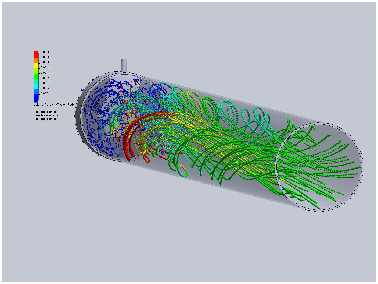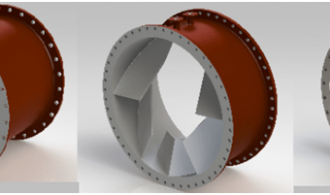The wind tunnel was invented in 1871 to explore fluid flows and turbulence. Despite immense effort to develop formulae that would predict fluid behaviour, every aircraft (and most motor vehicles) are still wind tunnel tested today. The reason for this is that fluid flows are chaotic and unpredictable and there is no complete substitute for prototyping and taking real measurements.

The principles of static mixing are similar, so it’s no surprise that choosing the ideal contours for any given industrial process can be difficult.
Why static mixing?
A static mixer interjected in a pipeline allows a manufacturing process to proceed continually. When the flow is consistent so is the result. By contrast, moving mixers require vats that divide production into batches. Differences in input flows or mixer movements introduce inconsistencies between batches (or within a single batch). Filling and emptying the vat slows down production and increases overheads.
Bubbles cause quality inconsistencies, so another advantage of inline static mixers is that pipelines are airtight. This also protects foodstuffs from pathogens, whereas vats may require expensive HVAC strategies to meet food protection standards.
Mixer parameters
Despite the simplicity of the principle – a blade that disrupts flow passing over it – mixers come in many variations. They differ in diameter, length, shape, number of internal elements, blade profiles, construction materials, surface treatments, fitting mechanisms, and additional features.
While the advice of a mixing specialist like https://www.statiflo.com/ is priceless, some basic questions narrow down your choices:

Which combination of mixing elements, pipeline bores and pumps (if any) will produce the flow rate that your production process requires?
What is the ideal length for the mixer unit itself, given space constraints and the mixing achievable within it?
Do the ingredients need to be introduced at locations that are physically hard to reach? Mixers can often be customised with extensions.
Will your process require other specialised attachments? Again, mixers are often customised with special control mechanisms and monitoring sensors, or to feed into follow-on processes or bespoke containers.
Are the proposed mixing elements strong enough to withstand the driving pressure (which may be gravity, screw or pump driven)? The forces on your elements vary with both the driving pressure and the frictional or adhesive qualities of flowing materials. If they exceed their parameters, chemicals may squeeze past the mixer along the walls.

